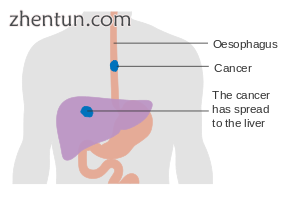
食道癌是由食道引起的癌症 - 食道管在喉咙和胃之间流动。[2]症状通常包括吞咽困难和体重减轻。[1]其他症状可能包括吞咽时疼痛,声音嘶哑,锁骨周围淋巴结肿大(“腺体”),干咳,可能咳嗽或吐血[1]。
该疾病的两个主要亚型是食管鳞状细胞癌(通常缩写为ESCC),[9]在发展中国家更常见,食管腺癌(EAC)在发达国家更常见。 [2]还会出现一些不太常见的类型。[2]鳞状细胞癌起源于排列食管的上皮细胞[10]。腺癌起源于存在于食管下三分之一的腺细胞,通常它们已经转变为肠细胞类型(称为Barrett食管的病症)。[2] [11]鳞状细胞类型的原因包括烟草,酒精,极热饮,不良饮食和嚼槟榔。[3] [4]腺癌类型最常见的原因是吸烟,肥胖和胃酸反流。[3]
通过内窥镜(光纤相机)进行活组织检查来诊断该疾病。[5]预防包括戒烟和健康饮食。[2] [1]治疗基于癌症的阶段和位置,以及患者的一般状况和个人偏好。[5]小的局限性鳞状细胞癌可以单独用手术治疗,希望能治愈。[5]在大多数其他情况下,有或没有放射治疗的化疗与手术一起使用。[5]较大的肿瘤可能通过化疗和放射治疗减缓其生长。[2]在存在广泛疾病的情况下,或者如果受影响的人不适合接受手术,通常建议采用姑息治疗。[5]
截至2012年,食管癌是全球第八大常见癌症,年内有456,000例新病例。[2]它导致当年约有40万人死亡,高于1990年的345,000人。[2] [12]不同国家的费率差别很大,约有一半的病例发生在中国。[2]男性比女性多三倍。[2]结果与疾病的程度和其他医疗条件有关,但通常往往相当差,因为诊断通常较晚。[2] [13]五年生存率约为13%至18%。[1] [6]
目录
1 症状和体征
2 原因
2.1 鳞状细胞癌
2.2 腺癌
2.3 相关条件
3 诊断
3.1 临床评估
3.2 类型
3.3 分期
4 预防
4.1 筛选
5 管理
5.1 手术
5.2 化疗和放疗
5.3 其他方法
5.4 后续行动
6 预后
7 流行病学
7.1 美国
7.2 英国
8 社会与文化
8.1 值得注意的案例
9 研究方向
10 另见
11 参考文献
12 外部链接
视频:↓ 气管食管瘘(TEF,TOF)
https://cache.tv.qq.com/qqplayerout.swf?vid=x0721924i3n
视频:↓ 食管癌的手术,食管切除术
https://cache.tv.qq.com/qqplayerout.swf?vid=g0721ztyxi6
视频:↓ 食管癌 科普视频
https://cache.tv.qq.com/qqplayerout.swf?vid=z0721bqpvnn
迹象和症状
Endoscopic image of an esophageal adenocarcinoma
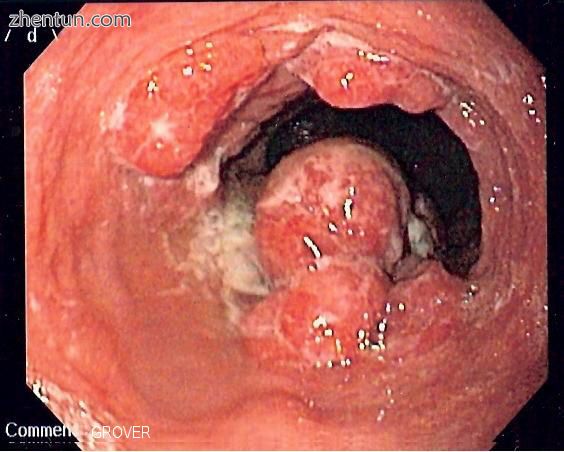
食管腺癌的内镜图像
突然出现的症状通常不会出现,直到癌症已经渗透超过食道管周长的60%,此时肿瘤已经处于晚期阶段。[14]症状的发作通常是由于肿瘤的实际存在导致的管变窄引起的。[15]
第一个也是最常见的症状通常是吞咽困难,通常首先使用固体食物,然后使用较软的食物和液体。[1]吞咽时疼痛最初不太常见。[1]体重减轻通常是鳞状细胞癌的初始症状,但通常不是在腺癌的情况下。[16]由于食欲减退和营养不良导致的最终体重减轻很常见。[17]胸骨后面或胃周围区域的疼痛常常像胃灼热。当吞咽任何类型的食物时,疼痛可能经常是严重的,恶化。另一个迹象可能是异常沙哑,刺耳或嘶哑的咳嗽,这是肿瘤影响喉返神经的结果。
当吞咽时,肿瘤的存在可能破坏食道的正常收缩。这可能导致恶心和呕吐,食物反流和咳嗽。[14]由于食物通过食道和气管(气管)之间可能发生的异常连接(瘘管)进入呼吸道,吸入性肺炎[14]的风险也增加[13]。这种严重并发症的早期迹象可能是咳嗽时饮酒或进食。[18]肿瘤表面可能是脆弱的并且出血,导致血液呕吐。局部结构的压缩发生在晚期疾病中,导致上呼吸道阻塞和上腔静脉综合征等问题。可能会发生高钙血症(血液中过量的钙)。[14]
如果癌症已在其他地方传播,则可能出现与转移性疾病相关的症状。常见的传播部位包括附近的淋巴结,肝脏,肺和骨骼。[14]肝转移可引起黄疸和腹部肿胀(腹水)。除其他症状外,肺转移可导致由于肺周围过多的液体(胸腔积液)引起的呼吸受损,以及呼吸困难(通常与呼吸受损有关的感觉)。
原因
两种主要类型(即鳞状细胞癌和腺癌)具有不同的风险因素。[16]鳞状细胞癌与生活方式因素有关,如吸烟和酗酒。[19]腺癌与长期胃酸反流的影响有关。[19]烟草是两种类型的风险因素。[16]这两种类型在60岁以上的人群中更常见。[20]
鳞状细胞癌
食管鳞状细胞癌的两个主要危险因素是烟草(吸烟或咀嚼)和酒精[2]。烟草和酒精的结合具有很强的协同效应。[21]一些数据显示,所有病例中约有一半是由烟草引起的,约三分之一是由酒精引起的,而男性中超过四分之三的病例是由吸烟和大量饮酒引起的。[2]与酒精相关的风险似乎与其醛代谢物和某些相关酶的突变有关。[16]这种代谢变异在亚洲相对普遍。[2]
其他相关风险因素包括经常食用极热饮料(超过65°C或149°F)[22] [23]和摄入腐蚀性物质。[2]膳食中亚硝胺的高水平暴露(烟草烟雾和某些食品中都含有化合物)似乎也是一个相关的风险因素。[16]不利的膳食模式似乎涉及通过加工和烧烤肉类,腌制蔬菜等接触亚硝胺,以及摄入少量新鲜食物。[2]其他相关因素包括营养缺乏,社会经济地位低下和口腔卫生差。[16]咀嚼槟榔(槟榔)是亚洲的一个重要危险因素。[4]
身体创伤可能会增加风险。[24]这可能包括喝热饮料。[3]
腺癌
Esophageal cancer (lower part) as a result of Barrettʼs esophagus
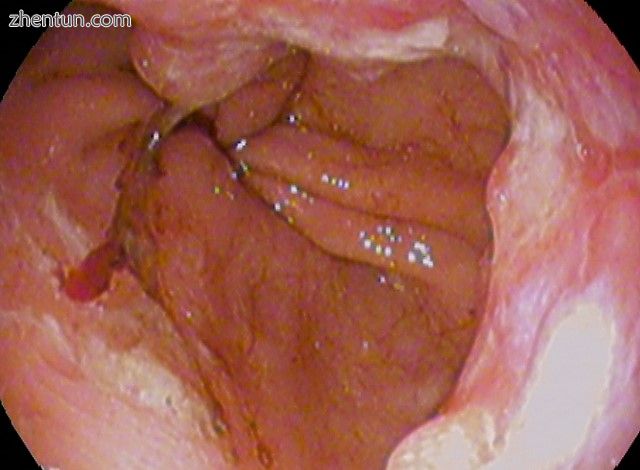
食管癌(下部)是Barrett食管的结果
在这种类型的食管癌中男性占优势尤其强烈,男性患病率高出约7至10倍。[25]这种不平衡可能与其他已知风险因素的特征和相互作用有关,包括胃酸反流和肥胖。[25]
酸反流(一种极为常见的疾病,也称为胃食管反流病或GERD)的长期侵蚀作用与此类癌症密切相关。[26]长期的GERD可以诱导食管下部细胞类型的变化,以应对其鳞状内层的侵蚀。[26]这种被称为Barrett食管的现象似乎在女性中大约出现20年,而不是男性,可能是由于荷尔蒙因素。[26]有症状的GERD或胆汁反流使Barrett的食管更容易发生,这反过来又增加了可能最终导致腺癌的进一步变化的风险。[16]存在Barrett食管时发生腺癌的风险尚不清楚,过去可能被高估了。[2]
肥胖或超重似乎都与风险增加有关。[27]与肥胖的关系似乎是任何类型的肥胖相关癌症中最强的,尽管其原因尚不清楚。[28]腹部肥胖似乎特别重要,因为它与这种类型的癌症以及GERD和Barrett食管的关系密切相关。[28]这种肥胖症是男性的特征。[28]在生理上,它刺激GERD并且还具有其他慢性炎症效应。[26]
幽门螺杆菌感染(一种常见的事件被认为影响了世界一半以上的人口)不是食管腺癌的危险因素,实际上似乎是保护性的。尽管是GERD的原因和胃癌的危险因素,但感染似乎与食道腺癌的风险降低高达50%[29] [30]。对保护作用的生物学解释有些不清楚。[30]一种解释是,一些幽门螺杆菌菌株会减少胃酸,从而减少GERD的损害。[31]近几十年来西方人群中幽门螺杆菌感染率下降,这与更好的卫生和增加食物冷藏有关,可能是食管腺癌同时增加的一个因素。[29]
女性荷尔蒙也可能具有保护作用,因为EAC不仅在女性中不常见,而且在以后的生命中发展,平均为20年。虽然对许多生殖因素的研究尚未产生清晰的图像,但母亲的风险似乎随着长时间的母乳喂养而下降。[29]
吸烟会增加风险,但与鳞状细胞癌相比,食管腺癌的影响较小,并且酒精尚未被证实是原因。[29]
相关条件
头颈部癌症与该地区的第二原发性肿瘤相关,包括食管鳞状细胞癌,由于野外癌症(即对长期致癌暴露的区域反应)。[32] [33]
胸部其他疾病的放射治疗史是食管腺癌的危险因素[16]。
意外或故意吞咽苛性物质对食管的腐蚀性损伤是鳞状细胞癌的危险因素。[2]
食管癌发病是一种罕见的家族性疾病,伴有常染色体显性遗传,与17号染色​​体上存在的RHBDF2基因突变有关:它涉及手掌和足底皮肤增厚以及鳞状细胞癌的高寿命风险[2] [34]
由于被困食物和饮料的停滞,至少在男性中,失弛缓症(即吞咽后缺乏食道中的无意识反射)似乎是两种主要类型食管癌的危险因素。[35]
Plummer-Vinson综合征(一种涉及食管网的罕见疾病)也是一个危险因素。[2]
有证据表明人乳头瘤病毒(HPV)与食管鳞状细胞癌之间可能存在因果关系[36]。这种关系尚不清楚。[37]在某些亚洲国家,包括中国,这种疾病发病率特别高的地方,HPV的可能相关性可能更大[38]。[39]
乳糜泻与食道癌之间存在关联。未经治疗的乳糜泻患者风险较高,但这种风险在诊断后随着时间的推移而降低,这可能是由于采用无麸质饮食,这似乎对乳糜泻患者的恶性肿瘤发展有保护作用。然而,延迟诊断和开始无谷蛋白饮食似乎增加了恶性肿瘤的风险。此外,在某些情况下,乳糜泻的检测是由于癌症的发展,其早期症状与乳糜泻中可能出现的症状类似。[40]
诊断
Esophageal cancer as shown by a filling defect during an upper GI series
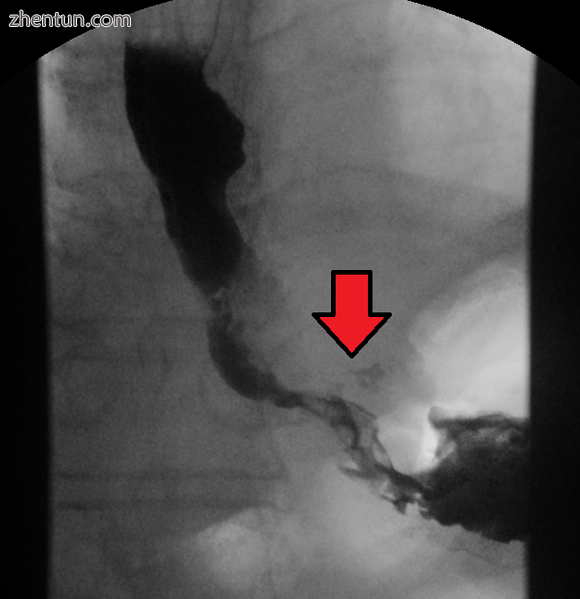
食管癌由上GI系列期间的充盈缺损所示
临床评估
虽然钡吞或钡餐可能怀疑闭塞性肿瘤,但最好通过内窥镜检查进行诊断。这涉及将带有光和照相机的柔性管通过食道并检查壁,并称为食管胃十二指肠镜检查。然后在组织学上检查对可疑病变的活组织检查以检查恶性肿瘤的迹象。
需要进行额外的测试以评估癌症扩散的程度(参见下面的#Staging)。胸部,腹部和骨盆的计算机断层扫描(CT)可以评估癌症是否已扩散到邻近组织或远处器官(尤其是肝脏和淋巴结)。 CT扫描的灵敏度受其检测通常大于1cm的肿块(例如肿大的淋巴结或受累的器官)的能力的限制。正电子发射断层扫描也用于估计疾病的程度,并且被认为比单独的CT更精确。食管内镜超声可以提供关于肿瘤侵袭水平的分期信息,以及可能扩散到区域淋巴结。
肿瘤的位置通常通过距牙齿的距离来测量。为了确定位置,食道(25厘米或10英寸长)通常分为三个部分。腺癌往往更靠近胃部和鳞状细胞癌发生在喉部附近,但任何一种都可能出现在食道的任何部位。
Endoscopic image of Barrett esophagus – a frequent precursor of esophageal adenocarcinoma
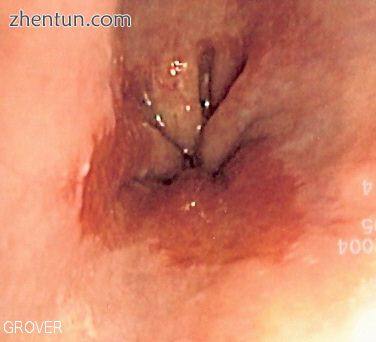
Barrett食管的内镜图像 - 食管腺癌的常见前兆
Endoscopy and radial endoscopic ultrasound images of a submucosal tumor in the central portion of th ...
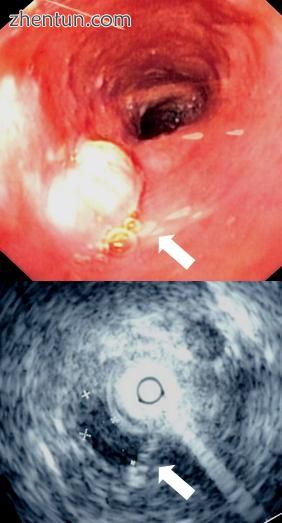
在食道中央部分的粘膜下肿瘤的内窥镜检查和径向内窥镜超声图像
Contrast CT scan showing an esophageal tumor (axial view)
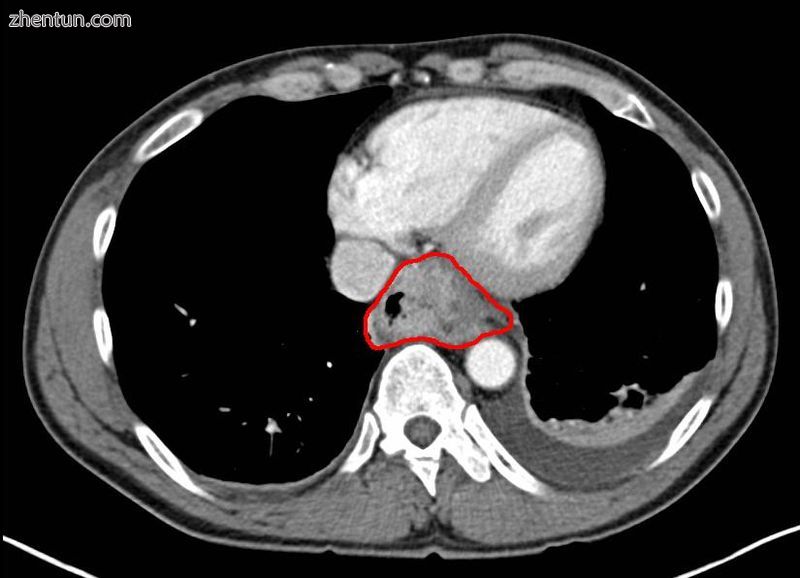
对比CT扫描显示食管肿瘤(轴向视图)
Contrast CT scan showing an esophageal tumor (coronal view)
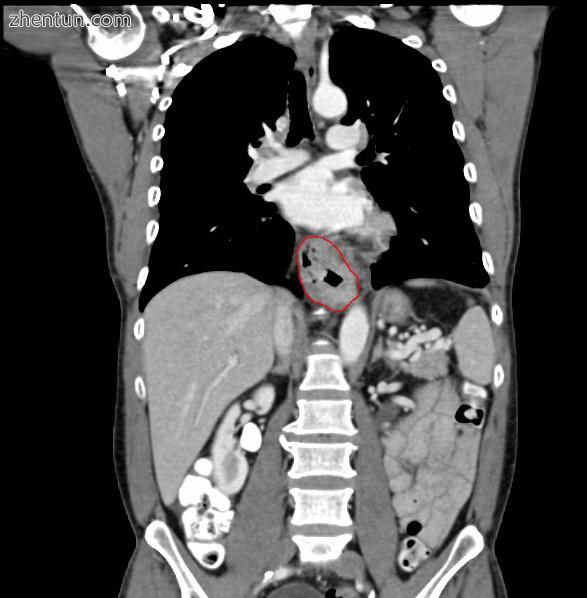
对比CT扫描显示食管肿瘤(冠状视图)
Esophageal cancer
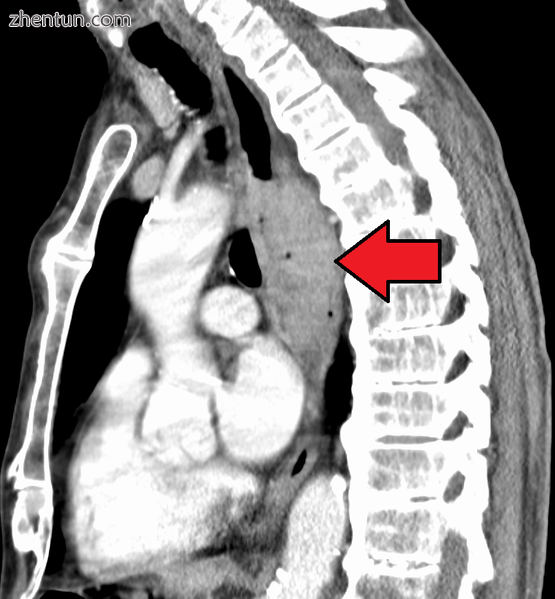
食道癌
Micrograph showing histopathological appearance of an esophageal adenocarcinoma (dark blue – upper- ...
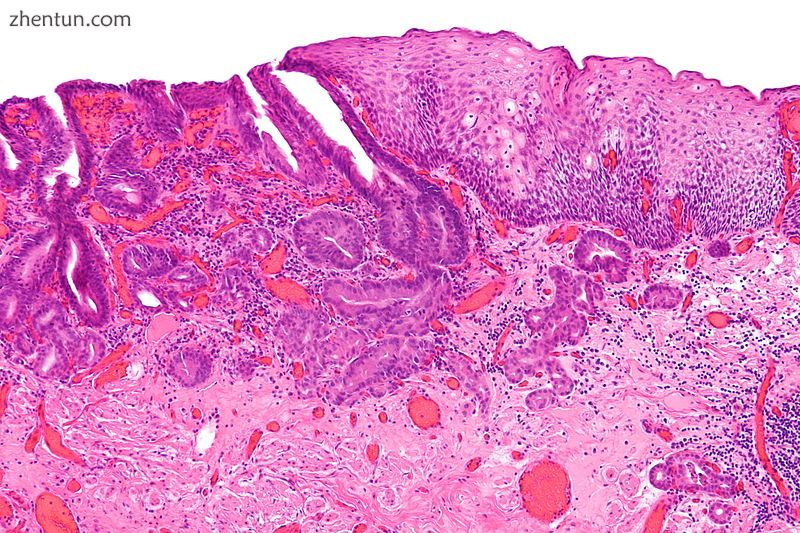
显微照片显示H&E染色时食管腺癌(深蓝色 - 图像左上方)和正常鳞状上皮(图像右上方)的组织病理学表现
类型
食道癌通常是由食道上皮或表面衬里引起的癌。大多数食管癌属于两类:食管鳞状细胞癌(ESCC),其外观和与烟草和酒精消耗相关的头颈癌和食管腺癌(EAC)相似,通常与GERD和Barrett食道的历史。根据经验,上三分之二的癌症很可能是ESCC,一个是下三分之一的EAC。
罕见的食管癌组织学类型包括鳞状细胞癌和非上皮性肿瘤的不同变异,如平滑肌肉瘤,恶性黑色素瘤,横纹肌肉瘤和淋巴瘤等[41] [42]。
分期
分期基于TNM分期系统,该系统分类肿瘤侵袭(T),淋巴结受累(N)和远处转移(M)[16]。目前首选的分类是2010年AJCC食管癌和食管胃连接分期系统。[16]为了帮助指导临床决策,该系统还包括细胞类型(ESCC,EAC等),分级(分化程度 - 癌细胞的生物攻击性指示)和肿瘤位置(上,中,较低的,或交界的[43])。[44]
T1, T2, and T3 stages of esophageal cancer
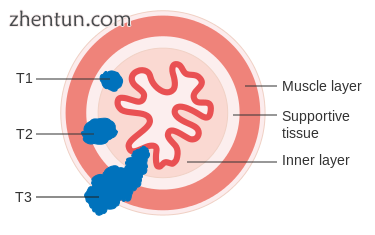
食管癌的T1,T2和T3阶段
Stage T4 esophageal cancer
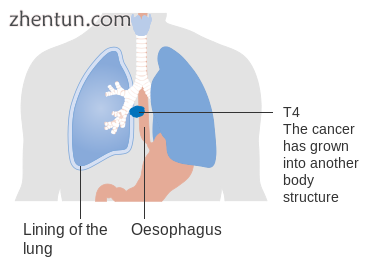
T4阶段食道癌
Esophageal cancer with spread to lymph nodes
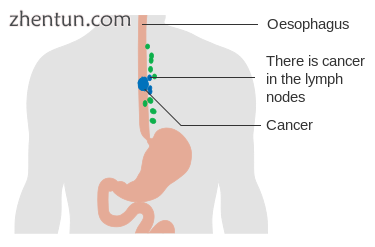
食道癌扩散到淋巴结
预防
预防包括戒烟或嚼烟。[2]克服在亚洲咀嚼槟榔的成瘾是另一种预防食管鳞状细胞癌的有希望的策略。[4]通过维持正常体重也可以降低风险。[45]
据美国国家癌症研究所称,“十字花科高的食物(卷心菜,西兰花/西兰花,花椰菜,布鲁塞尔豆芽)和绿色和黄色蔬菜和水果与食道癌风险降低有关。”[46]膳食纤维被认为是保护,特别是对食道腺癌。[47]没有证据表明维生素补充剂会改变风险。[1]
筛选
患有Barrett食管的人(食管下部细胞发生变化)的风险要高得多[48],可能会定期接受内镜筛查以确定癌症的早期症状[49]。因为在没有症状的人群中筛查腺癌的好处尚不清楚,[2]在美国不推荐使用[1]。世界上一些鳞状癌发病率高的地区都有筛查项目。[2]
管理
Esophageal stent for esophageal cancer
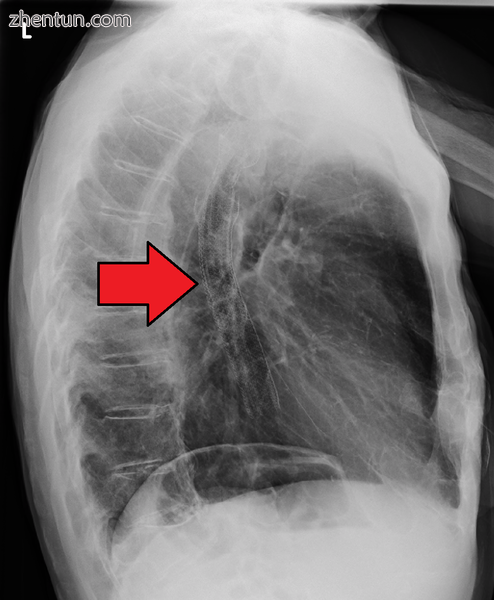
食管支架治疗食管癌
Esophageal stent for esophageal cancer
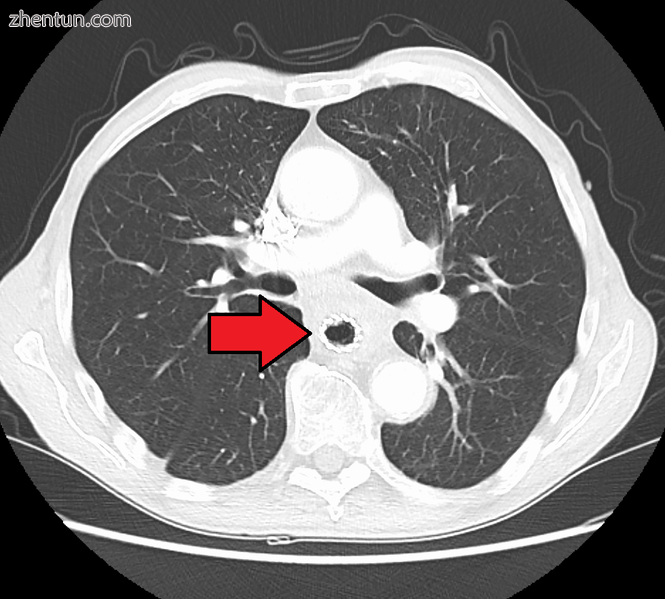
食管支架治疗食管癌
Before and after a total esophagectomy
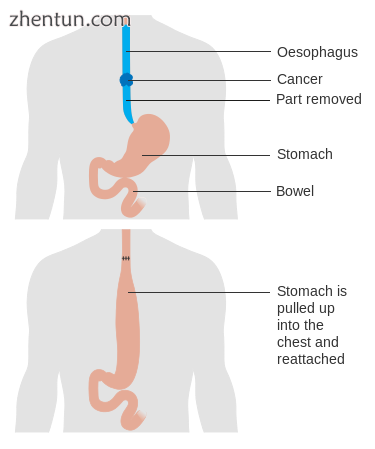
完全食管切除术前后
Typical scar lines after the two main methods of surgery
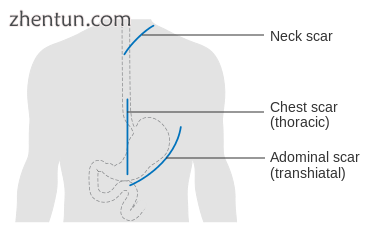
两种主要手术方法后的典型瘢痕线
治疗最好由多学科团队管理,涵盖所涉及的各种专业。[50] [51]必须确保充足的营养,并且必须进行适当的牙科护理。影响治疗决策的因素包括癌症的阶段和细胞类型(EAC,ESCC和其他类型),以及人的一般状况和存在的任何其他疾病。[16]
一般而言,治疗意图的治疗局限于局部疾病,没有远处转移:在这种情况下,可以考虑包括手术的组合方法。广泛,转移或复发的疾病是姑息性管理的:在这种情况下,化疗可用于延长生存期,而放疗或支架置入等治疗可用于缓解症状并使其更容易吞咽。[16]
手术
进一步的信息:食管切除术
如果癌症在仍处于早期阶段时已经被诊断出来,则可以进行具有治愈意图的手术治疗。一些仅涉及粘膜或食管内层的小肿瘤可通过内镜下黏膜切除术(EMR)切除[52] [53]。否则,早期病变的治愈性手术可能需要切除全部或部分食道(食管切除术),尽管这是一种难以操作且具有相对高的死亡风险或术后困难的手术。早期ESCC手术的益处不如EAC明显。有许多手术选择,特殊情况的最佳选择仍然是研究和讨论的主题。[50] [54] [55]除了肿瘤的特征和位置,其他因素包括患者的状况,以及手术团队最有经验的手术类型。
在考虑手术时,治疗后可能的生活质量是一个相关因素。[56]在经常进行手术的大型中心,手术结果可能更好。[54]如果癌症已扩散到身体的其他部位,那么现在通常不进行食管切除术。[54] [57]
食管切除术是切除一段食管;因为这缩短了剩余食道的长度,消化道的一些其他部分被拉过胸腔并插入。这通常是胃或大肠(结肠)或空肠的一部分。将胃重新连接到缩短的食道称为食管胃吻合术。[54]
食管切除术可以使用几种方法进行。手术方法的选择取决于肿瘤的特征和位置,以及外科医生的偏好。缺乏临床试验的明确证据,其中方法在不同情况下取得最佳结果。[54]关于入境点的第一个决定是在经胸和经胸手术之间。最近的横向方法避免了打开胸部的需要;相反,外科医生通过下腹部的切口和颈部的另一个切口进入身体。食道的下部从周围组织中释放出来并在必要时切除。然后将胃推过食道裂孔(食道穿过膈肌的孔),并将其连接到颈部食道的剩余上部。[54]
传统的经胸入路通过胸部进入身体,并有许多变化。胸腹入路将腹腔和胸腔一起打开,两阶段Ivor Lewis(也称为Lewis-Tanner)方法包括初始剖腹术和胃管构建,然后进行右胸廓切开术以切除肿瘤并产生食管胃吻合术。三阶段McKeown方法在颈部增加第三个切口以完成颈部吻合术。一些外科医生最近的方法使用所谓的扩展食管切除术,其中包括淋巴结在内的更多周围组织被整体移除。[54]
如果患者根本不能吞咽,可以插入食道支架以保持食道开放;支架也可以帮助阻塞瘘管。在给予肿瘤治疗的同时,可能需要鼻胃管来继续喂食,并且一些患者需要胃造口术(在皮肤中的进食孔直接进入胃)。如果患者倾向于将食物或唾液吸入气道,则易于吸入性肺炎,后两者尤为重要。
化疗和放疗
化学疗法取决于肿瘤类型,但往往是连续或每三周用氟尿嘧啶(5-FU)每三周一次顺铂(或卡铂或奥沙利铂)。在最近的研究中,加入表阿霉素比其他晚期不可切除癌症的可比方案更好[需要澄清]。[58] [需要医学引证]术前可给予化学疗法(辅助,即降低复发风险),术前(新辅助)或者如果不能进行手术;在这种情况下,使用顺铂和5-FU。正在进行的试验比较了各种化疗组合; II期/ III期REAL-2试验 - 例如 - 比较四种含有表阿霉素和顺铂或奥沙利铂的方案,以及连续输注的氟尿嘧啶或卡培他滨。
在化疗或手术之前,期间或之后给予放射疗法,有时单独用于控制症状。对于局部疾病但手术禁忌的患者,“根治性放疗”可以与治疗意图一起使用。
其他方法
内镜治疗的形式已用于0期和I期疾病:内镜下粘膜切除术(EMR)[59]和使用射频消融,光动力疗法,Nd-YAG激光或氩等离子体凝固的粘膜消融。
激光疗法是使用高强度光来破坏肿瘤细胞,同时仅影响治疗区域。如果不能通过手术除去癌症,通常会这样做。堵塞的缓解可以帮助解决疼痛和吞咽困难。光动力疗法是一种激光疗法,涉及使用被癌细胞吸收的药物;当暴露在特殊光线下时,药物变得活跃并破坏癌细胞。
Internal radiotherapy for esophageal cancer
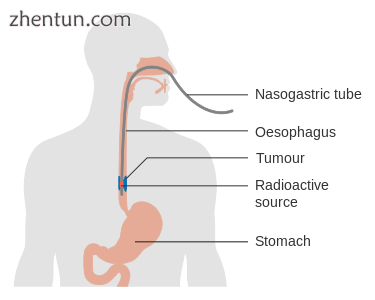
食管癌的内部放疗
Self-expandable metallic stents are sometimes used for palliative care
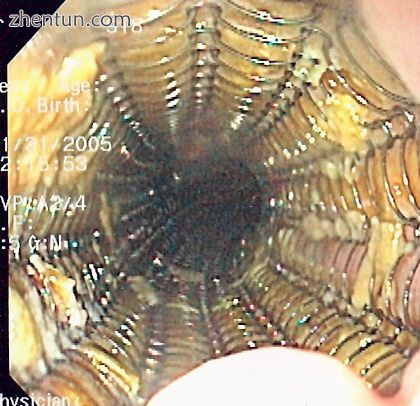
自膨式金属支架有时用于姑息治疗
跟进
治疗方案完成后,患者密切关注。通常,其他治疗方法用于改善症状和最大限度地提高营养。
预测
一般来说,食管癌的预后很差,因为大多数患者都患有晚期疾病。当出现第一个症状(例如吞咽困难)时,疾病已经发展。美国的整体五年生存率(5YSR)约为15%,大多数人在诊断的第一年内死亡。[60]英格兰和威尔士(2007年诊断的患者)的最新生存数据显示,十分之一的人在食管癌中存活至少十年。[61]
个体化预后在很大程度上取决于阶段。癌症完全受限于食管粘膜的患者约有80%的5YSR,但粘膜下受累使其低于50%。延伸到固有肌层(食道肌肉层)表明20%5YSR,并且与食道相邻的结构的延伸预测7%5YSR。远处转移的患者(不是治疗性手术的候选者)的5YSR低于3%[需要引证]
流行病学
Death from esophageal cancer per million persons in 2012
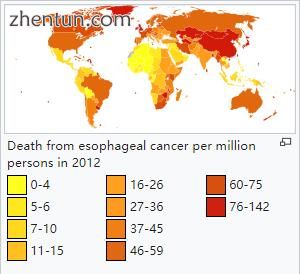
2012年每百万人死于食道癌
食管癌是全球第八大最常被诊断出的癌症[2],由于其预后不良,它是癌症相关死亡的第六大常见原因。[48]它在2012年导致约400,000人死亡,占所有癌症死亡人数的约5%(诊断出约456,000个新病例,约占所有癌症的3%)。[2]
ESCC占全球食管癌病例的60-70%,而EAC占20-30%(黑色素瘤,平滑肌肉瘤,类癌和淋巴瘤不常见)。[62]两种主要类型的食管癌的发病率在不同的地理区域之间差异很大。[63]总的来说,ESCC在发展中国家更为常见,EAC在发达国家更为常见。[2]
2012年ESCC的全球发病率为每100,000人年5.2个新病例,男性占优势(男性为7.7 / 100,000,女性为2.8)。[64]这是所研究国家中90%的常见类型。[64] ESCC在所谓的“亚洲食管癌带”中尤为常见,该带通过中国北部,俄罗斯南部,伊朗东北部,阿富汗北部和土耳其东部。[62] 2012年,全世界大约80%的ESCC病例发生在中亚和东南亚,超过一半(53%)的病例发生在中国。[64]估计全国发病率最高的国家是(在亚洲)蒙古和土库曼斯坦以及(在非洲)马拉维,肯尼亚和乌干达。[64]食管癌的问题早已在撒哈拉以南非洲的东部和南部地区得到认可,ESCC似乎在那里占主导地位。[65]
在西方国家,随着最近几十年的发病率增加(与ESCC的发病率基本保持稳定相反),EAC已成为该疾病的主要形式。[5] [29] 2012年,EAC的全球发病率为每10万人0.7例,男性占优势(男性为1.1 / 100,000,女性为0.3)。发病率特别高的地区包括北欧和西欧,北美洲和大洋洲。记录率最高的国家是英国,荷兰,爱尔兰,冰岛和新西兰。[64]
美国
在美国,食道癌是男性癌症死亡的第七大原因(占总数的4%)。[66]美国国家癌症研究所估计,2013年大约有18,000例新发病例和超过15,000例食道癌死亡(美国癌症协会估计,在2014年,将诊断出约18,170例新的食管癌病例,导致15,450例死亡)。[63] [66]鳞状细胞癌类型在具有大量吸烟或酗酒史的非洲裔美国男性中更为常见。直到20世纪70年代,鳞状细胞癌在美国占绝大多数食管癌。近几十年来,食管腺癌(与Barrett食管相关)的发病率在美国稳步上升至现已超过鳞状细胞癌。与鳞状细胞癌相反,食道腺癌在高加索人(60岁以上)中比在非洲裔美国人中更常见。多项报告显示,在过去的20年中,食管腺癌的发病率有所增加,尤其是非西班牙裔白人。从1973年到1997年,新墨西哥州的食管腺癌年龄调整发病率增加。这种增加发生在非西班牙裔白人和西班牙裔美国人中,并且在非西班牙裔白人中占主导地位。[67]非裔美国人的食管癌发病率和死亡率继续高于Causasians的发病率。然而,自20世纪80年代初以来,非裔美国人的食管癌发病率和死亡率显着下降,而高加索人则继续增加。[68] 1975年至2004年间,美国白人男性的腺癌发病率增加了460%,白人美国女性增加了335%。[63]
英国
近几十年来,英国食管腺癌的发病率大幅上升。[16] 总体而言,食管癌是英国第十三大常见癌症(2011年约有8,300人被诊断患有该病),并且是癌症死亡的第六大常见原因(2012年约有7,700人死亡)。[69]
社会与文化
值得注意的案例
另见:类别:食道癌死亡
以“上帝不伟大”这本书而闻名的作家克里斯托弗·希钦斯(Christopher Hitchens)也写了关于他患食道癌的生活。[70]
莫里西在2015年10月表示,他患有这种疾病并描述了他第一次听到他的经历时的经历。[71]
研究方向
使用阿司匹林或相关NSAID的人可能会降低食管鳞状细胞癌的风险[72],但在没有随机对照试验的情况下,目前的证据尚无定论。[2] [29]
也可以看看
食管胃交界腺癌
参考:
1. Ferri, FF, ed. (2012). "Tumors". Ferri's clinical advisor 2013. Philadelphia, PA: Mosby (Elsevier). pp. 389–391. ISBN 978-0323083737. Archived from the original on 2015-09-19.
2.Montgomery, EA; et al. (2014). "Oesophageal Cancer". In Stewart, BW; Wild, CP. World Cancer Report 2014. World Health Organization. pp. 528–543. ISBN 9283204298.
3. Zhang, HZ; Jin, GF; Shen, HB (Jun 2012). "Epidemiologic differences in esophageal cancer between Asian and Western populations". Chinese journal of cancer. 31 (6): 281–6. doi:10.5732/cjc.011.10390. PMC 3777490 Freely accessible. PMID 22507220.
4. Akhtar, S (February 2013). "Areca nut chewing and esophageal squamous-cell carcinoma risk in Asians: a meta-analysis of case-control studies". Cancer Causes & Control. 24 (2): 257–65. doi:10.1007/s10552-012-0113-9. PMID 23224324.
5. Stahl, M; Mariette, C; Haustermans, K; Cervantes, A; Arnold, D; ESMO Guidelines Working, Group (Oct 2013). "Oesophageal cancer: ESMO Clinical Practice Guidelines for diagnosis, treatment and follow-up". Annals of Oncology. 24 Suppl 6: vi51–6. doi:10.1093/annonc/mdt342. PMID 24078662. Archived from the original on 2016-03-23.
6. "SEER Stat Fact Sheets: Esophageal Cancer". National Cancer Institute. Archived from the original on 6 July 2014. Retrieved 18 June 2014.
7. GBD 2015 Disease and Injury Incidence and Prevalence, Collaborators. (8 October 2016). "Global, regional, and national incidence, prevalence, and years lived with disability for 310 diseases and injuries, 1990-2015: a systematic analysis for the Global Burden of Disease Study 2015". Lancet. 388 (10053): 1545–1602. doi:10.1016/S0140-6736(16)31678-6. PMC 5055577 Freely accessible. PMID 27733282.
8. GBD 2015 Mortality and Causes of Death, Collaborators. (8 October 2016). "Global, regional, and national life expectancy, all-cause mortality, and cause-specific mortality for 249 causes of death, 1980-2015: a systematic analysis for the Global Burden of Disease Study 2015". Lancet. 388 (10053): 1459–1544. doi:10.1016/s0140-6736(16)31012-1. PMC 5388903 Freely accessible. PMID 27733281.
9. Even by those using the British English spelling "oesophagus"
10. Kelsen, David (2007). Gastrointestinal oncology: principles and practices (2nd ed.). Philadelphia, Pa.: Lippincott Williams & Wilkins. p. 4. ISBN 9780781776172. Archived from the original on 2015-09-25.
11. Whittemore, edited by David Schottenfeld, Joseph F. Fraumeni Jr.; associate editors, Graham A. Colditz, Jonathan M. Samet, Alice S. (2006). Cancer epidemiology and prevention (3rd ed.). Oxford: Oxford University Press. p. 697. ISBN 9780199747979. Archived from the original on 2015-10-31.
12. Lozano, R; Naghavi, M; Foreman, K; Lim, S; Shibuya, K; Aboyans, V; Abraham, J; Adair, T; et al. (Dec 15, 2012). "Global and regional mortality from 235 causes of death for 20 age groups in 1990 and 2010: a systematic analysis for the Global Burden of Disease Study 2010". Lancet. 380 (9859): 2095–128. doi:10.1016/S0140-6736(12)61728-0. PMID 23245604.
13. Enzinger PC, Mayer RJ (2003). "Esophageal cancer" (PDF). N. Engl. J. Med. 349 (23): 2241–52. doi:10.1056/NEJMra035010. PMID 14657432. Archived from the original (PDF) on 2014-07-14.
14. Mayer RJ (2008). "Gastrointestinal Tract Cancer". In Longo DL, Fauci AS, Kasper DL, Hauser SL, Jameson JL, Loscalzo J. Harrison's principles of internal medicine. 1 (18th ed.). New York: McGraw-Hill Medical Publishing Division. pp. 764–5. ISBN 978-0071748896.
15. Cheifetz, Adam S; Brown, Alphonso; Curry, Michael; Moss, Alan C (2011). Oxford American Handbook of Gastroenterology and Hepatology. Oxford University Press. p. 106. ISBN 978-0-19-983012-1.
16. Pennathur A, Gibson MK, Jobe BA, Luketich JD (February 2013). "Oesophageal carcinoma". Lancet. 381 (9864): 400–12. doi:10.1016/S0140-6736(12)60643-6. PMID 23374478.
17. Yamada, Tadataka (2011). Textbook of Gastroenterology. John Wiley & Sons. pp. 1590–1. ISBN 978-1-4443-5941-1. Archived from the original on 2015-09-20.
18. Gerdes, Hans; Ferguson, Mark K (2002). "Palliation of Esophageal Cancer". In Posner, Mitchell C; Vokes, Everett E; Weichselbaum, Ralph R. Cancer of the Upper Gastrointestinal Tract. PMPH-USA. p. 184. ISBN 978-1-55009-101-4. Archived from the original on 2015-10-30.
19. Lao-Sirieix, P; Caldas, C; Fitzgerald, RC (June 2010). "Genetic predisposition to gastro-oesophageal cancer". Current Opinion in Genetics & Development. 20 (3): 210–7. doi:10.1016/j.gde.2010.03.002. PMID 20347291.
20. Tobias JS, Hochhauser D (2013). Cancer and its management (6th ed.). p. 254. ISBN 1-11871-325-7.
21. Prabhu, A; Obi, KO; Rubenstein, JH (June 2014). "The synergistic effects of alcohol and tobacco consumption on the risk of esophageal squamous cell carcinoma: a meta-analysis". The American Journal of Gastroenterology. 109 (6): 822–7. doi:10.1038/ajg.2014.71. PMID 24751582.
22. Loomis, D; Guyton, KZ; Grosse, Y; et al. (July 2016). "Carcinogenicity of drinking coffee, mate, and very hot beverages" (PDF). The Lancet. Oncology. 17 (7): 877–8. doi:10.1016/s1470-2045(16)30239-x. PMID 27318851. Archived (PDF) from the original on 2016-10-05.
23. "Q&A on Monographs Volume 116: Coffee, maté, and very hot beverages" (PDF). www.iarc.fr. IARC / WHO. Archived (PDF) from the original on 5 July 2016.
24. Hunter, edited by Blair A. Jobe, Charles R. Thomas Jr., John G. (2009). Esophageal cancer principles and practice. New York: Demos Medical. p. 93. ISBN 9781935281177. Archived from the original on 2017-09-10.
25. Rutegård M, Lagergren P, Nordenstedt H, Lagergren J (July 2011). "Oesophageal adenocarcinoma: the new epidemic in men?". Maturitas. 69 (3): 244–8. doi:10.1016/j.maturitas.2011.04.003. PMID 21602001.
26. de Jonge, PJ; van Blankenstein, M; Grady, WM; Kuipers, EJ (January 2014). "Barrett's oesophagus: epidemiology, cancer risk and implications for management". Gut. 63 (1): 191–202. doi:10.1136/gutjnl-2013-305490. PMID 24092861. Archived from the original on 2014-01-07.
27. Turati F, Tramacere I, La Vecchia C, Negri E (March 2013). "A meta-analysis of body mass index and esophageal and gastric cardia adenocarcinoma". Annals of Oncology. 24 (3): 609–17. doi:10.1093/annonc/mds244. PMID 22898040. Archived from the original on 2014-05-16.
28. Lagergren J (June 2011). "Influence of obesity on the risk of esophageal disorders". Nature Reviews. Gastroenterology & Hepatology. 8 (6): 340–7. doi:10.1038/nrgastro.2011.73. PMID 21643038.
29. Lagergren, J; Lagergren, P (2013). "Recent developments in esophageal adenocarcinoma". CA: A Cancer Journal for Clinicians. 63 (4): 232–48. doi:10.3322/caac.21185. PMID 23818335.
30. Falk, GW (July 2009). "Risk factors for esophageal cancer development" (PDF). Surgical Oncology Clinics of North America. 18 (3): 469–85. doi:10.1016/j.soc.2009.03.005. PMID 19500737. Archived (PDF) from the original on 2014-08-12.
31. Harris, Randall E (2013). "Epidemiology of Esophageal Cancer". Epidemiology of Chronic Disease: Global Perspectives. Burlington, MA: Jones & Bartlett Publishers. pp. 157–161. ISBN 978-0-7637-8047-0. Archived from the original on 2015-09-25.
32. Priante AV, Castilho EC, Kowalski LP (April 2011). "Second primary tumors in patients with head and neck cancer". Current Oncology Reports. 13 (2): 132–7. doi:10.1007/s11912-010-0147-7. PMID 21234721.
33. Scherübl H, Steinberg J, Schwertner C, Mir-Salim P, Stölzel U, de Villiers EM (June 2008). "'Field cancerization' im oberen Aerodigestivtrakt" [Coincidental squamous cell cancers of the esophagus, head, and neck: risk and screening]. HNO (in German). 56 (6): 603–8. doi:10.1007/s00106-007-1616-7. PMID 17928979.
34. "Tylosis with esophageal cancer". rarediseases.info.nih.gov. Genetic and Rare Diseases Information Center (GARD) – NIH. 18 January 2013. Archived from the original on 19 August 2014. Retrieved 16 August 2014.
35. Nyrén O, Adami HO (2008). "Esophageal Cancer". In Adami HO, Hunter DJ, Trichopoulos D. Textbook of Cancer Epidemiology. Volume 1. Oxford University Press. p. 224. ISBN 978-0-19-531117-4. Archived from the original on 2015-10-25.
36. Liyanage SS, Rahman B, Ridda I, Newall AT, Tabrizi SN, Garland SM, Segelov E, Seale H, Crowe PJ, Moa A, Macintyre CR (2013). "The aetiological role of human papillomavirus in oesophageal squamous cell carcinoma: a meta-analysis". PLOS ONE. 8 (7): e69238. doi:10.1371/journal.pone.0069238. PMC 3722293 Freely accessible. PMID 23894436.
37. Sitas F, Egger S, Urban MI, Taylor PR, Abnet CC, Boffetta P, O'Connell DL, Whiteman DC, Brennan P, Malekzadeh R, Pawlita M, Dawsey SM, Waterboer T (January 2012). "InterSCOPE study: Associations between esophageal squamous cell carcinoma and human papillomavirus serological markers". Journal of the National Cancer Institute. 104 (2): 147–58. doi:10.1093/jnci/djr499. PMC 3260131 Freely accessible. PMID 22228147.
38. Syrjänen, K (January 2013). "Geographic origin is a significant determinant of human papillomavirus prevalence in oesophageal squamous cell carcinoma: systematic review and meta-analysis". Scandinavian Journal of Infectious Diseases. 45 (1): 1–18. doi:10.3109/00365548.2012.702281. PMID 22830571.
39. Hardefeldt, HA; Cox, MR; Eslick, GD (June 2014). "Association between human papillomavirus (HPV) and oesophageal squamous cell carcinoma: a meta-analysis". Epidemiology and Infection. 142 (6): 1119–37. doi:10.1017/S0950268814000016. PMID 24721187.
40. Han Y, Chen W, Li P, Ye J (2015). "Association Between Coeliac Disease and Risk of Any Malignancy and Gastrointestinal Malignancy: A Meta-Analysis". Medicine (Baltimore). 94 (38): e1612. doi:10.1097/MD.0000000000001612. PMC 4635766 Freely accessible. PMID 26402826.
41. Shields TW, LoCicero JW, Reed CE, Feins RH (2009). General Thoracic Surgery. Lippincott Williams & Wilkins. pp. 2047–. ISBN 978-0-7817-7982-1. Archived from the original on 2015-10-25.
42. Halperin EC, Perez CA, Brady LW (2008). Perez and Brady's Principles and Practice of Radiation Oncology. Lippincott Williams & Wilkins. pp. 1137–. ISBN 978-0-7817-6369-1. Archived from the original on 2015-10-19.
43. Cancer arising at the junction between the esophagus and stomach is often classified as stomach cancer, as in ICD-10. See: "C16 - Malignant neoplasm of the stomach". ICD-10 Version: 2015. World Health Organization. Archived from the original on 2 November 2015. Retrieved 14 November 2014.
44. Rice TW, Blackstone EH, Rusch VW (March 2010). "A cancer staging primer: esophagus and esophagogastric junction". The Journal of Thoracic and Cardiovascular Surgery. 139 (3): 527–9. doi:10.1016/j.jtcvs.2009.11.002. PMID 20176201.
45. Lauby-Secretan, B; Scoccianti, C; Loomis, D; Grosse, Y; Bianchini, F; Straif, K; International Agency for Research on Cancer Handbook Working, Group (25 August 2016). "Body Fatness and Cancer - Viewpoint of the IARC Working Group". The New England Journal of Medicine. 375 (8): 794–798. doi:10.1056/NEJMsr1606602. PMID 27557308.
46. NCI (2002). "Diet and oral, pharyngeal, and esophageal cancer". Nutr Cancer. 44 (2): 104–26. doi:10.1207/S15327914NC4402_01. PMID 12734057. Archived from the original on 2008-04-30.
47. Coleman HG, Murray LJ, Hicks B, Bhat SK, Kubo A, Corley DA, Cardwell CR, Cantwell MM (July 2013). "Dietary fiber and the risk of precancerous lesions and cancer of the esophagus: a systematic review and meta-analysis". Nutrition Reviews. 71 (7): 474–82. doi:10.1111/nure.12032. PMID 23815145.
48. Zhang Y (September 2013). "Epidemiology of esophageal cancer". World J. Gastroenterol. 19 (34): 5598–606. doi:10.3748/wjg.v19.i34.5598. PMC 3769895 Freely accessible. PMID 24039351.
49. Dunbar KB, Spechler SJ (May 2014). "Controversies in Barrett Esophagus". Mayo Clin. Proc. 89 (7): 973–984. doi:10.1016/j.mayocp.2014.01.022. PMID 24867396.
50. Tobias, Jeffrey S.; Hochhauser, Daniel (2010). Cancer and its Management (6th ed.). p. 257. ISBN 1118713257.
51. Berry 2014, p. S292
52. Fernández-Esparrach, G; Calderón, A; de la Peña, J; et al. (April 2014). "Endoscopic submucosal dissection". Endoscopy. 46 (4): 361–70. doi:10.1055/s-0034-1364921. PMID 24671864.
53. Sun, F; Yuan, P; Chen, T; Hu, J (7 May 2014). "Efficacy and complication of endoscopic submucosal dissection for superficial esophageal carcinoma: a systematic review and meta-analysis". Journal of cardiothoracic surgery. 9: 78. doi:10.1186/1749-8090-9-78. PMC 4052291 Freely accessible. PMID 24885614. Archived from the original on 3 October 2016.
54. "Ch 79, "Treatment"". DeVita, Hellman, and Rosenberg's Cancer: Cancer: Principles & Practice of Oncology (9th ed.). Lippincott Williams & Wilkins. 2011. ISBN 9781451105452. Online edition, with updates to 2014
55. Berry, MF (May 2014). "Esophageal cancer: staging system and guidelines for staging and treatment". Journal of thoracic disease. 6 (Suppl 3): S289–97. doi:10.3978/j.issn.2072-1439.2014.03.11. PMC 4037413 Freely accessible. PMID 24876933.
56. Parameswaran R, McNair A, Avery KN, Berrisford RG, Wajed SA, Sprangers MA, Blazeby JM (September 2008). "The role of health-related quality of life outcomes in clinical decision making in surgery for esophageal cancer: a systematic review". Annals of Surgical Oncology. 15 (9): 2372–9. doi:10.1245/s10434-008-0042-8. PMID 18626719.
57. Berry 2014, p. S293
58. Ross P, Nicolson M, Cunningham D, et al. (April 2002). "Prospective randomized trial comparing mitomycin, cisplatin, and protracted venous-infusion fluorouracil (PVI 5-FU) With epirubicin, cisplatin, and PVI 5-FU in advanced esophagogastric cancer". Journal of Clinical Oncology. 20 (8): 1996–2004. doi:10.1200/JCO.2002.08.105. PMID 11956258.
59. Wang KK, Prasad G, Tian J (September 2010). "Endoscopic mucosal resection and endoscopic submucosal dissection in esophageal and gastric cancers". Curr. Opin. Gastroenterol. 26 (5): 453–8. doi:10.1097/MOG.0b013e32833e4712. PMC 3215503 Freely accessible. PMID 20703112.
60. Polednak AP (May 2003). "Trends in survival for both histologic types of esophageal cancer in US surveillance, epidemiology and end results areas". Int. J. Cancer. 105 (1): 98–100. doi:10.1002/ijc.11029. PMID 12672037.
61. "Oesophageal cancer survival statistics". Cancer Research UK. Archived from the original on 2014-10-08.
62. Conteduca V, Sansonno D, Ingravallo G, Marangi S, Russi S, Lauletta G, Dammacco F (August 2012). "Barrett's esophagus and esophageal cancer: an overview". International Journal of Oncology. 41 (2): 414–24. doi:10.3892/ijo.2012.1481. PMID 22615011. Archived from the original on 2013-05-17.
63. Napier KJ, Scheerer M, Misra S (May 2014). "Esophageal cancer: A Review of epidemiology, pathogenesis, staging workup and treatment modalities". World Journal of Gastrointestinal Oncology. 6 (5): 112–20. doi:10.4251/wjgo.v6.i5.112. PMC 4021327 Freely accessible. PMID 24834141. Archived from the original on 2014-07-14.
64. Arnold M, Soerjomataram I, Ferlay J, Forman D (October 2014). "Global incidence of oesophageal cancer by histological subtype in 2012". Gut. 64: 381–7. doi:10.1136/gutjnl-2014-308124. PMID 25320104.
65. Kachala R (September 2010). "Systematic review: epidemiology of oesophageal cancer in Sub-Saharan Africa". Malawi Medical Journal. 22 (3): 65–70. doi:10.4314/mmj.v22i3.62190. PMC 3345777 Freely accessible. PMID 21977849.
66. "Cancer Facts and Figures 2014" (PDF). American Cancer Society. Archived (PDF) from the original on 29 April 2014. Retrieved 28 April 2014.
67. Vega KJ, Jamal MM (September 2000). "Changing pattern of esophageal cancer incidence in New Mexico". Am. J. Gastroenterol. 95 (9): 2352–6. doi:10.1111/j.1572-0241.2000.02329.x. PMID 11007241.
68. "Incidence and Mortality Rate Trends" (PDF). A Snapshot of Esophageal Cancer. National Cancer Institute. September 2006. Archived from the original (PDF) on 2007-03-16. Retrieved 2007-03-21.
69. "Oesophageal cancer statistics". Cancer Research UK. Archived from the original on 6 October 2014. Retrieved 3 October 2014.
70. "Christopher Hitchens' widow on his death: "God never came up"". www.cbsnews.com. Archived from the original on 30 October 2015. Retrieved 11 November 2015.
71. "Morrissey Talks Trump, Cancer Diagnosis, TSA Groping With Larry King". Rolling Stone. Archived from the original on 9 December 2015. Retrieved 11 November 2015.
72. Sun, L; Yu, S (Nov 2011). "Meta-analysis: non-steroidal anti-inflammatory drug use and the risk of esophageal squamous cell carcinoma". Diseases of the Esophagus. 24 (8): 544–9. doi:10.1111/j.1442-2050.2011.01198.x. PMID 21539676. |